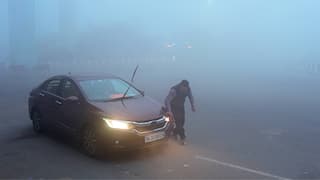Black Hole Winds Are No Longer Powerful Like Before. Study Explains Why
Winds blown by supermassive black holes at the centres of galaxies were much more frequent and more powerful during the first billion years of the universe, than those observed in today's galaxies.

New Delhi: Winds blown by supermassive black holes at the centres of galaxies were much more frequent and more powerful during the first billion years of the universe, than those observed in today's galaxies, some 13 billion years later. Winds slowed down the growth of supermassive black holes from which they originated as they were mighty, according to a new study.
The findings of the study, led by researchers from the Italian National Institute for Astrophysics (INAF) in Trieste, were recently published in the journal Nature.
The researchers observed 30 quasars with the Very Large Telescope at European Southern Observatory's (ESO) Paranal Observatory in Chile.
What Are Quasars?
A quasar is a very bright object in space that is similar to a star and very far away from Earth, and gives off powerful radio waves. It is a brilliant beacon of intense light from the centre of a distant galaxy that can outshine the entire galaxy, and is powered by a supermassive black hole voraciously feeding on inflating matter, unleashing a torrent of radiation, according to NASA. Astronomers suggest that quasars contain massive black holes and may represent a stage in the evolution of some galaxies. Therefore, quasars are extremely bright, point-like sources at the cores of distant galaxies, whose emission arises from the intense activity of the central supermassive black holes sucking in the surrounding matter, the study authors explained. The host galaxies of quasars were observed around cosmic dawn, when the universe was between 500 million and one billion years old.
In A First, Fraction Of Quasars In Young Universe Exhibiting Black Hole Winds Measured
In a statement issued by INAF, Manuela Biscetti, the first author of the study, said that for the first time, researchers measured the fraction of quasars in the young universe exhibiting black hole winds. She added that unlike what is observed in the universe closer to Earth, the researchers discovered that black hole winds in the young universe are very frequent, have high speeds up to 17 per cent of the speed of light, and inject large amounts of energy into their host galaxy.
According to the study, about half of the quasars observed in this research show black hole winds, which are more frequent and 20 times more powerful than the ones known when the universe was around four billion years old.
Black Holes Of Young Universe Grew Much Faster Than Host Galaxies
Chiara Feruglio, who co-authored the study, said that observations of black holes in the young universe show that they grew much faster than their host galaxies, whereas in the local universe, it is known that black holes and galaxies co-evolve. She explained that this implies that a mechanism must have acted at some point in the universe, slowing down black hole growth. The team's observations enabled it to identify this mechanism in the black hole winds produced when the universe was 0.5 to one billion years old.
Energy Provided By Winds Slows Down Black Hole Growth
According to the study, the energy injected by winds would have thus been able to halt further matter accretion onto the black hole, slowing down its growth and starting a "common evolution" phase between the black hole and its host galaxy. Bischetti explained that the study allowed the researchers to identify the epoch in the history of the universe during which the impact of black hole winds started being significant. She added that this has a huge impact on scientists' knowledge of the initial phases of growth of black holes and their host galaxies, setting strong constraints on the models that describe the formation of the first galaxies.
How Very Large Telescope Helped Researchers Conduct The Study
This was a totally unexpected discovery, and was made possible by the high-quality data from the X-shooter instrument installed on the Very Large Telescope installed in the context of a large ESO program with around 250 hours of observations.
Valentina D'Odorico, another co-author of the study, said that quasars are among the brightest objects observable in the early universe, but due to their distance, they are quite faint in terms of observed magnitude.
She added that the large investment of time dedicated to observing these objects and the unique capacities of X-shooter in terms of efficiency, wavelength coverage, and resolving power have allowed the researchers to obtain very good quality spectra which enabled this interesting result.
Andrea Ferrara, another co-author of the study, said that scientists have had indications for a few years that black holes one billion times more massive than the Sun could launch powerful winds that travel at a speed equal to 20 percent of the speed of light into their surroundings. He added that today, there is confirmation of the fact that black holes one billion times more massive than the Sun could launch powerful winds that travel at a speed equal to 20 per cent of the speed of light into their surroundings, thanks to data obtained with a European telescope by a team with a strong Italian imprint and leadership.
Ferrara said that the Scuola Normale Superiore in Pisa, Italy, had contributed to the theoretical interpretation side. The discovery of these spectacular galactic winds at such remote times could have had enormous and as yet unexplored implications for the birth and evolution of galaxies like the Milky Way.
Related Video
Southern Rising Summit 2024: How Important is Self-Awareness? Insights from Anu Aacharya | ABP LIVE






































